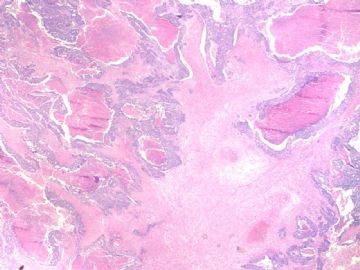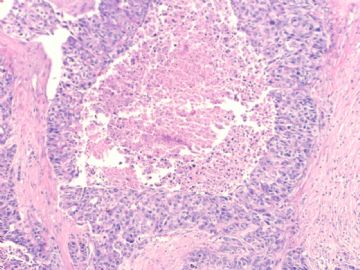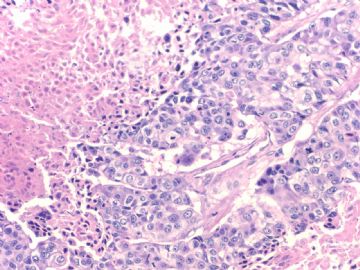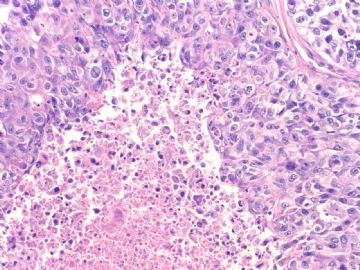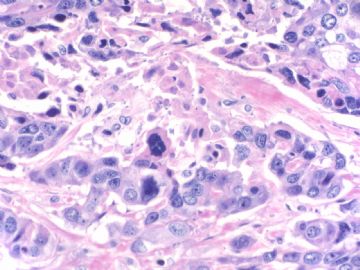| 图片: | |
|---|---|
| 名称: | |
| 描述: | |
- B20Breast basal-like carcinoma (cqz 6)
-
本帖最后由 heye 于 2013-03-17 09:04:14 编辑
- PMID:
- 23000897
- [PubMed - indexed for MEDLINE]
- [PubMed - indexed for MEDLINE]
- PMCID:
- PMC3465532
- [Available on 2013/3/23]
http://www.west-info.eu/files/studio-di-nature-cancro-al-seno.pdf
http://www.nature.com/nature/journal/v490/n7418/full/nature11412.html
Comprehensive molecular portraits of human breast tumours.
Abstract
We analysed primary breast cancers by genomic DNA copy number arrays, DNA methylation, exome sequencing, messenger RNA arrays, microRNA sequencing and reverse-phase protein arrays. Our ability to integrate information across platforms provided key insights into previously defined gene expression subtypes and demonstrated the existence of four main breast cancer classes when combining data from five platforms, each of which shows significant molecular heterogeneity. Somatic mutations in only three genes (TP53, PIK3CA and GATA3) occurred at >10% incidence across all breast cancers; however, there were numerous subtype-associated and novel gene mutations including the enrichment of specific mutations in GATA3, PIK3CA and MAP3K1 with the luminal A subtype. We identified two novel protein-expression-defined subgroups, possibly produced by stromal/microenvironmental elements, and integrated analyses identified specific signalling pathways dominant in each molecular subtype including a HER2/phosphorylated HER2/EGFR/phosphorylated EGFR signature within the HER2-enriched expression subtype. Comparison of basal-like breast tumours with high-grade serous ovarian tumours showed many molecular commonalities, indicating a related aetiology and similar therapeutic opportunities. The biological finding of the four main breast cancer subtypes caused by different subsets of genetic and epigenetic abnormalities raises the hypothesis that much of the clinically observable plasticity and heterogeneity occurs within, and not across, these major biological subtypes of breast cancer.

- binglihe
-
Am J Surg Pathol. 2009 Apr 22. [Epub ahead of print]
-
Basal Cytokeratin and Epidermal Growth Factor Receptor Expression Are Not Predictive of BRCA1 Mutation Status in Women With Triple-negative Breast Cancers.
*Department of Pathology, Beth Israel Deaconess Medical Center daggerDepartment of Pathology, Brigham and Women's Hospital and Harvard Medical School parallelDepartments of Medical Oncology and Cancer Biology, Dana-Farber Cancer Institute, Boston, MA double daggerKlinik für Gynäkologie und Gynäkologische Onkologie, Dr Horst Schmidt Klinik, Wiesbaden, Germany section signDivision of Medical Oncology, Memorial Sloan-Kettering Cancer Center, New York, NY.
BACKGROUND: Over 80% of breast cancers in women with germline BRCA1 mutations are estrogen receptor, progesterone receptor, and human epidermal growth factor receptor 2-negative ("triple negative") and most of these have a basal-like phenotype by expression profiling and immunophenotypic analysis. However, whether or not expression of biomarkers characteristic of basal-like breast cancers helps to define a subset of women with triple-negative breast cancers who are likely to harbor BRCA1 mutations is an unresolved issue. METHODS: We randomly identified 165 women from the Dana-Farber/Harvard Cancer Center SPORE annotated specimen bank with primary invasive, triple-negative breast cancers. Tissue microarrays were constructed by obtaining triplicate 0.6 mm cores from available paraffin blocks from 130 cases: only unstained slides were available for immunostaining from 35 cases. Slides cut from the tissue microarrays and the unstained slides were immunostained for estrogen receptor, progesterone receptor, and human epidermal growth factor receptor 2 (to confirm triple-negative status) and for several markers that have been reported to be useful in defining the basal-like phenotype, including basal cytokeratins CK5/6, CK14, and CK17 and epidermal growth factor receptor (EGFR). Full sequencing analysis for BRCA1 germline mutations was performed on blood specimens from all cases. The final study population consisted of 144 cases in which (1) triple-negative status was confirmed; (2) there was sufficient material for analysis of basal cytokeratins and EGFR; and (3) germline BRCA1 mutation status was known. RESULTS: Among these triple-negative breast cancer cases, 97 (67%) expressed one or more basal cytokeratins and 102 (71%) showed EGFR expression. Basal cytokeratin expression was detected in 65% of the tumor from the 20 BRCA1 mutation carriers and in 68% of the cancers from women without mutations (P=NS). EGFR expression was identified in a similar proportion of tumors from women with and without BRCA1 mutations (75% vs. 72%, P=NS). CONCLUSIONS: Basal cytokeratin and EGFR expression are both highly prevalent among triple-negative breast cancers. The frequency of expression of basal cytokeratins and EGFR was similar in women with and without BRCA1 mutations. Therefore, although the expression of basal cytokeratins and/or EGFR can be used to identify triple-negative breast cancers that have a basal-like phenotype, expression of these markers alone is not sufficient to distinguish which women with triple-negative breast cancers are likely to harbor BRCA1 germline mutations.
-
本帖最后由 于 2009-03-03 01:47:00 编辑
You know all sugjects. I only know some breast/gyn/cyto and no others. So you are more valuable.
In fact pathologists need to sign out all even in most hospitals in the US. Only in few very large academic centers, pathologists sign out for their own subspecielties.
Thank for teaching me the word. No I know a new chinese word.
Agree that pathologists 要广泛地学习,仔细地询问,缜密地思考,明确地分辨,踏踏实实地实践.
You pick a name which is consistent with your personality.
| 以下是引用cqzhao在2009-3-2 20:39:00的发言:
笃行者 , …… 笃: how to call this word? Why did you choose the user name 笃行者 ? Could u let us know if u do not mind. |
哈哈,笃(du三声,音同“赌”),忠实、专心、一心一意的意思:———笃行而不倦。
博学之,审问之,慎思之,明辨之,笃行之。——《中庸》
意思是说:要广泛地学习,仔细地询问,缜密地思考,明确地分辨,踏踏实实地实践。
我们病理医生不正是这样做的吗。这也是我的座右铭。而其中最主要的我认为还是“笃行”,所以我就是“笃行者”。
呵呵,见笑见笑。


- 博学之,审问之,慎思之,明辨之,笃行之。
-
本帖最后由 于 2009-03-03 19:53:00 编辑
| 以下是引用cqzhao在2009-3-2 20:39:00的发言:
笃行者 , Thank you. From your discussion in many topics, I can tell you are an experienced and excellent breast pathologist. …… |

- 博学之,审问之,慎思之,明辨之,笃行之。
| 以下是引用kint123在2009-2-7 22:32:00的发言:
也就是说仅用于癌或非癌的鉴别诊断问题? 今天看了一篇有关“gene-expression profiling”的review,感觉世界发展太快了,有的东西国内跟不上 |
